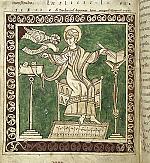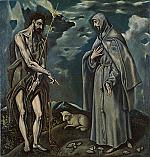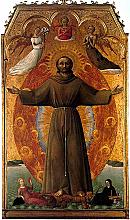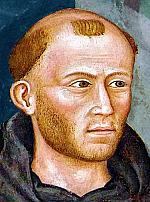Praying and preaching for a better church and society
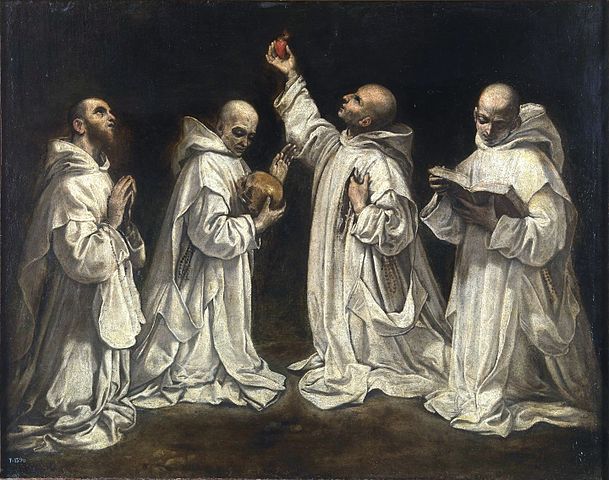
[Rutilio di Lorenzo Manetti, The Vision of Saint Bruno, oil on canvas, 1550 to 1650—The Prado Museum / Public domain, Wikimedia File:Visión de San Bruno, de Rutilio Manetti. (Museo del Prado).jpg]
Bruno of Cologne (c. 1030–1101), encourager of prayer
Bruno was born into a well-known Cologne family around 1030 and studied theology in Reims (in modern-day France). After a short stint at St. Cunibert’s in Cologne, Bishop Gervais called Bruno back to Reims to head a cathedral school until 1075. Among his pupils was Odo of Châtillon, the future Pope Urban II.
In 1075 Bruno became chancellor of the church in Reims but soon had to flee because of his protestations against the corruption of new archbishop Manasses de Gournay. In 1080 Manasses was deposed, but by that point, Bruno wanted nothing to do with any positions of ecclesiastical power. With like-minded friends, he retreated to mountains near Grenoble and began the Carthusian order in 1084.
Instead of codifying new rules for his order, Bruno modified the Benedictine Rule. The Carthusians lived in solitary cells, practiced poverty, and spent their time in study and prayer. Odo, now pope, called the reluctant Bruno to Rome as part of an effort to surround himself with devout advisors in 1090. Bruno advised the pope but wanted no real power for himself, even rejecting the pope’s offer of the archbishopric of Reggio, Italy.
Instead Bruno created a second Carthusian community in Calabria. The Order of Carthusians today consists of 21 charterhouses, 16 for monks and 5 for nuns. Almost a thousand years after its founding, the order still emphasizes humility and shared solitude.
Clare of Assisi (1194–1253), radical leader
Clare was from a wealthy family; her parents desired her to marry a rich young man when she was 12 years old. She begged to wait until she was 18, during which time she heard Francis of Assisi preach in a local church. Moved, she decided to dedicate her life to God. On Palm Sunday, 1212, she left her home and went to the Porziuncola Chapel to meet Francis; the bishop of Assisi, Guido II, agreed to Clare’s decision.
A few days later, Clare took her vows, initiating the Second Order of St. Francis, the Poor Clares. Eventually other women joined, including her own mother and sister, Agnes. They lived in the church and convent in San Damiano, near Assisi. By 1216 Clare was abbess. The sisters kept to a life of poverty and seclusion in accordance with Francis’s Rule. They forewent shoes, slept on the ground, and lived almost in silence. Unlike Franciscan friars, who were itinerant preachers, the women instead spent their time in prayer and manual labor.
Increasingly prelates urged the sisters to follow a new rule, closer to the Rule of St. Benedict. But Clare defended the Rule of St. Francis. Some called her alter Franciscus, “another Francis.” After Francis’s death Clare fought against every pope who attempted to minimize their vow of extreme poverty. Finally, after years of infighting, Pope Gregory IX gave the Poor Clares special dispensation for their “radical commitment to corporate poverty.”
As soon as the pope approved the order’s vows, Clare began articulating a rule for the sisters to follow after she died. Based on Francis’s teaching and Clare’s own convictions, her rule forbade, among other things, any possession of property. Clare died at the age of 59, and within 10 years, the order she so loved was christened the Order of Saint Clare.
John Wycliffe (c. 1328–1384), preacher of the Gospel
Born in northern England, John Wycliffe moved to Oxford as a teenager to further his education. By 1360 he became a professor of philosophy, while also pursuing his own study of theology and Scripture. He earned his doctorate in divinity in 1372.
Grieved by the Catholic Church’s abuses, Wycliffe took aim at the clergy and the institution. In the 1370s he wrote three works criticizing corruption. In On Divine Dominion (1373–1374), Wycliffe decried the pope’s dishonesty, arguing that papal authority is not based in Scripture.
Then, in On Civil Dominion (1375–1376), he questioned England’s support of a corrupt Roman church, arguing that the English crown should not be forced to bow to a crooked external organization. Finally, in On the Truth of Sacred Scripture (1378), he continued to assert the Bible’s authority over ecclesiastical traditions. All three works laid the groundwork for future reforms.
Though many church leaders discouraged translation into the common language, Wycliffe was convinced that “it helps Christian men to study the Gospel in that tongue which they know best.” Wycliffe and other scholars not only translated Scripture, but hand-copied hundreds of Bibles that an order of Poor Preachers disseminated across England, preaching the gospel as they went.
Wycliffe died in 1384 after suffering a stroke. Considered by some as a precursor to the Protestant Reformation because of his harsh criticism of the pope, the church, and transubstantiation, his infamy among church leadership continued well after his death. Thirty-one years after his burial, the Council of Constance declared him a heretic, exhumed and burned his bones, and scattered the ashes in the River Swift.
Julian of Norwich (c. 1343–after 1416), devotional writer
Little is known of Julian’s life, though it is safe to assume she lived most if not all of it in Norwich in East Anglia. Norwich was a cathedral city, and during her lifetime one of the most religious cities in Europe. The Black Plague arrived there when Julian was around the age of six. She could have been educated by Benedictine nuns at nearby Carrow Abbey, though no sure evidence exists.
When Julian was approximately 30 years old, on May 13, 1373, she was suddenly healed of a terrible illness after seeing visions of Christ’s sufferings and the Virgin Mary. After her healing she produced a “Short Text” of what she experienced during her visions. She spent the next two decades meditating on the meaning of Jesus’s revelations to her; her “Long Text” turned into Revelations of Divine Love, a rich theological treatise and the earliest known extant work of any Englishwoman.
By the 1390s Julian committed to living as an anchoress in Norwich’s St. Julian’s Church (which is why we call her Julian—her original name is unknown). Before becoming an anchoress, Julian had the Office of the Dead sung for her, as if she were at her own funeral. Then she was sealed into her cell, where she remained for the rest of her life. She devoted her life to prayer and would accept occasional visitors to her window, advising them on how to live in holiness.
Though she lived during a tumultuous time of revolt and plague, Julian always returned to the hope of Jesus:
You would know our Lord’s meaning in this thing? Know it well. Love was His meaning. Who showed it to you? Love. What did He show you? Love. Why did He show it? For love.
Jan Hus (c. 1370–1415), attacker of corruption
Born to a poor family in Bohemia (in the modern Czech Republic), Jan Hus was educated in a monastery around age 10, eventually matriculating at the University of Prague and becoming a professor there. Thinkers at the university were discussing the works of John Wycliffe, and Hus was impressed with his thoughts on reforming the clergy. In Bohemia the church held great power and wealth, often to the detriment of the peasant population because of oppressive taxes. Hus agreed with Wycliffe about the corruption and overreach of the church and the sin of the sale of indulgences.
Hus was appointed rector at the University of Prague and began ardent preaching—in Czech, not Latin—at Bethlehem Chapel. During Hus’s tenure at the church, the Western Schism—with one pope in Rome and one in Avignon, France—was in full swing, creating chaos in Europe. King Wenceslaus IV of Bohemia gave Czech clergy the freedom to preach as they felt led, and Hus’s reform views quickly spread.
But reform-minded Hussites began butting heads with the church in Bohemia, and in 1411 three of Hus’s followers were declared heretics and executed. Wen-ceslaus tried to reconcile them the next year, but Hus could not defy his conscience by declaring the pope the head of the church: the Scriptures, he believed, made clear that role was reserved for Christ alone.
During the Council of Constance in 1414, Catholic officials arrested Hus after preaching. Hus said he would recant his beliefs if someone could show him from Scripture, and not church teaching, where his views were wrong, but officials refused to argue with him. When he refused to recant, Hus was burned at the stake on July 6, 1415.
At his death he announced “[M]y declarations, teachings, writings, in fine, all my works, have been intended and shaped toward the object of rescuing dying men from the tyranny of sin.” Within less than a century, a young Martin Luther came upon Hus’s writings and exclaimed, “I was overwhelmed with astonishment. I could not understand for what cause they had burnt so great a man, who explained the Scriptures with so much gravity and skill.”
Margery Kempe (c. 1373–after 1438), traveling visionary
Born in Norfolk around 1373, Margery’s father was John Brunham, a merchant, mayor, and member of Parliament. Though from a prosperous family, Margery herself was illiterate. Around age 20, Margery married John Kempe, a town official. They had 14 children.
After the birth of her first child, Kempe spent eight months in crisis, experiencing numerous visions of demons and devils demanding she forsake her family and faith. Her husband and their servants finally restrained Kempe in bed to keep her from hurting herself. One day she woke up, and Jesus was sitting near her, asking, “Daughter, why have you forsaken me, and I never forsook you?” She was healed of her torments and rose from her bed.
Kempe became known in her town for doing constant penance and for her frequent sobbing as she would tell her friends and neighbors of Jesus’s love and forgiveness for her old life of sin. She also desired to remain chaste, although she knew that she had a wifely duty to sleep with her husband. Kempe avowed that her husband could have her body, but Jesus had her soul.
At age 40 Kempe began traveling and preaching, which was illegal for women. She was frequently tried for heresy—she associated loosely with the Lollards (followers of Wycliffe)—but was never convicted. In Kempe’s travels she visited Julian of Norwich, who reassured Kempe that her visions were from God.
By the 1430s Kempe decided to tell her life story with the help of a scribe (possibly her son). The Book of Margery Kempe is considered the first autobiography written in English, and it details her life story into her midsixties. The manuscript was rediscovered in a cupboard in 1934 in England after being effectively lost for centuries. It was officially published in 1940.
Bernardino of Siena (1380–1444), evangelist of repentance
Bernardino of Siena was born into a wealthy Tuscan family, orphaned as a young boy, and raised by his devout aunt. He joined the Confraternity of Our Lady, attached to a hospital. When the plague arrived in his region three years later, he attended to the sick and almost died of the plague himself. A few years later, he joined the Franciscan Order and became a priest in 1404.
Thirteen years later Bernardino began his famous preaching tours throughout Italy. Grieved by the Western Schism, he implored people to return to Christ’s teachings to restore lives and quell civil strife. Bernardino used themes and examples from the everyday lives of his listeners. He traveled by foot throughout Italy, usually preaching at dawn in town centers for up to four hours. He spoke against luxury, gambling, and blasphemy and encouraged his listeners to repent and seek lives of holiness.
Bernardino’s preaching was curtailed somewhat when in 1438 he was appointed vicar general of the Observant branch of the Franciscans. Under Bernardino’s leadership the Observant branch grew exponentially. He also helped found or reform hundreds of convents of friars, and he established missionary groups to minister throughout Asia. He still felt called to preaching, however, and in 1442 the pope accepted his resignation as vicar general. He died having preached in all corners of his native land in 1444.
Girolamo Savonarola (1452–1498), holiness reformer
Born in Ferrara, Italy, Savonarola was educated by his grandfather, a physician of strong principles, both moral and religious. Even in his teen years, Savonarola developed a hatred of the corruption he saw in Italy and mourned the humanistic paganism in the culture. He wrote to his father as a teenager that he abhorred “the blind wickedness of the peoples of Italy.”
In 1475 Savonarola decided to forego his study in medicine to enter the Dominican order in Bologna. In subsequent years he was a lecturer in Florence and an itinerant preacher in northern Italy. In 1490 Lorenzo de’ Medici (1449–1492) called Savonarola to Florence, where he spoke openly on government and church abuse of power. He preached to large crowds, calling for repentance before a great coming judgment.
In September 1494 it appeared that judgment had come to Florence. King Charles VIII of France crossed the Alps into Italy, bringing fear on the nation. As Charles was about to advance upon Florence, Savonarola visited the king in his camp outside the city, begging him to spare the city and become a reformer in the church. After Charles agreed to go south, Savonarola’s power and influence in Florence grew.
Savonarola wanted to make Florence a beacon of godliness in Italy, a place of order and faithfulness. He set up “bonfires of the vanities,” where luxury goods, cosmetics, and gaming tables were burned, and he continued to preach against corruption. But not everyone was pleased with Savonarola’s success. The Florentine Arrabbiati Party formed against him, with the Duke of Milan and Pope Alexander VI as patrons.
The pope kept trying to limit Savonarola’s success and influence, and he even tried to tempt Savonarola to become a cardinal, to which Savonarola replied, “A red hat? I want a hat of blood.” Pressure continued to build against Savonarola, with the pope finally excommunicating and then arresting him on Palm Sunday, 1498. He was executed on May 23 in front of a large crowd in Florence, still against corruption and for holiness, still devoted to the primary tenets of the Roman Catholic Church. CH
By Jennifer Boardman
[Christian History originally published this article in Christian History Issue #149 in 2023]
Jennifer Boardman is a freelance writer and editor. She holds a master of theological studies from Bethel Seminary with a concentration in Christian history.Next articles
Christian History Timeline: Reform, renewal, revival, reaction
Both clergy and laity sought a renewal of devotion and an end to corruption throughout the Middle Ages —but it was sometimes a bumpy road
the editors“Repair my house”
Francis of Assisi and his followers called the church back to holiness through vibrant preaching and voluntary poverty
Jon M. SweeneyWalking in the way of St. Francis
Recommendations for reform from the traveling preacher
Francis of AssisiWinds of spiritual renewal
Mystics looked inward to revive and renew the love of christ
Glenn E. MyersSupport us
Christian History Institute (CHI) is a non-profit Pennsylvania corporation founded in 1982. Your donations support the continuation of this ministry
Donate



